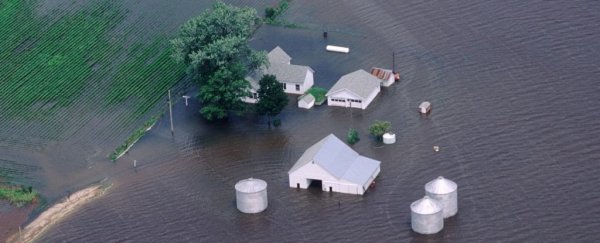A new federal report with up-to-date projections for all states and territories predicts sea levels in the United States will rise more than three times as fast as they did last century.
According to new lines of data, the average sea level along the nation's coastline could increase by 0.3 meters (or a foot) as soon as 2050 – the same amount as was seen between 1920 and 2020.
The 2022 Sea Level Rise Technical Report was produced by a task force of 23 co-authors representing the National Oceanic and Atmospheric Administration (NOAA), NASA, the Environmental Protection Agency, and several others.
NOAA administrator Rick Spinrad says the findings are "a global wake-up call". Even in the best case scenario, sea levels are rising at a dangerously rapid rate, and the US is not the only nation at risk of losing infrastructure to the sea.
If the world continues to emit fossil fuels at its current rate, the report estimates the US can expect between 0.5 and 1.5 meters of extra sea level rise (1.5 to 5 feet) come 2100. Ultimately, that could mean the sea climbs more than 2 meters higher (7 feet) by the century's end.
"This new data on sea rise is the latest reconfirmation that our climate crisis – as the President has said – is blinking 'code red'," says Gina McCarthy, the first White House National Climate Advisor.
"We must redouble our efforts to cut the greenhouse gases that cause climate change while, at the same time, help our coastal communities become more resilient in the face of rising seas."
The future effects of sea level rise in the US are profound. Coastal flooding from tide and storm surges will become much more likely over the next 30 years.
Major floods that are often destructive are projected to occur five times as often as they do today. Moderately damaging floods, meanwhile, are estimated to increase thirteen fold, while minor floods will strike more than three times as often.
And that's just the average. Some areas in the US, like the East Coast and the Gulf Coast will be hit by more floods than most. These regions are also where sea level rise tends to be occurring the fastest.
The West Coast and Hawaii, on the other hand, will experience lower than average effects from rising sea levels.
To help the public and policy makers visualize the future, researchers at NASA have also put together an online mapping tool, which allows users to zoom in on certain coastlines across the nation and see the local projected sea level rise.
"It takes a village to make climate predictions," says Nadya Vinogradova Shiffer, who leads the NASA Sea Level Change Team.
"When you combine NASA's scenarios of global sea level rise with NOAA's estimates of extreme water levels and the US Geological Survey's impact studies, you get a robust national estimate of the projected future that awaits American coastal communities and our economic infrastructure in 20, 30, or 100 years from now."
But even the most comprehensive report doesn't guarantee action. For years now, the world has received warning after warning from scientific bodies throughout the world on the disastrous effects of climate change, yet very little has been done to curb our fossil fuel emissions.
Geoscientist Andrea Dutton, who was not involved in the federal report, expressed her frustration over the matter to Seth Borenstein at the Associated Press.
"We can see this freight train coming from more than a mile away," Dutton told him in an email.
"The question is whether we continue to let houses slide into the ocean."
Earlier this year, researchers predicted climate change could increase the annual cost of flood damage in the US by 25 percent come 2050. Homes, businesses, even people are increasingly at risk from these effects.
In fact, 2021 was the deadliest year of flooding in the US since 2017, claiming the lives of 116 people.
Spinrad hopes the new federal report on sea level rise will help policymakers build a "Climate Ready Nation" that can protect people and property for years to come. Whether those dreams are met remains to be seen.
The full report is available on the NOAA website.
